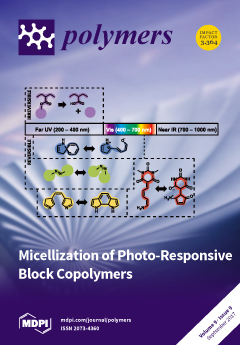A morphologically-stable polymer/fullerene heterojunction has been prepared by minimizing the intermixing between polymer and fullerene via sequential deposition (SqD) of a polymer and a fullerene solution. A low crystalline conjugated polymer of PCPDTBT (poly[2,6-(4,4-bis-(2-ethylhexyl)-4H-cyclopenta [2,1-b;3,4-b′]dithiophene)-alt-4,7(2,1,3-benzothiadiazole)]) has been utilized for the polymer layer and
[...] Read more.
A morphologically-stable polymer/fullerene heterojunction has been prepared by minimizing the intermixing between polymer and fullerene via sequential deposition (SqD) of a polymer and a fullerene solution. A low crystalline conjugated polymer of PCPDTBT (poly[2,6-(4,4-bis-(2-ethylhexyl)-4H-cyclopenta [2,1-b;3,4-b′]dithiophene)-alt-4,7(2,1,3-benzothiadiazole)]) has been utilized for the polymer layer and PC
71BM (phenyl-C
71-butyric-acid-methyl ester) for the fullerene layer, respectively. Firstly, a nanostructured PCPDTBT bottom layer was developed by utilizing various additives to increase the surface area of the polymer film. The PC
71BM solution was prepared by dissolving it in the 1,2-dichloroethane (DCE), exhibiting a lower vapor pressure and slower diffusion into the polymer layer. The deposition of the PC
71BM solution on the nanostructured PCPDTBT layer forms an inter-digitated bulk heterojunction (ID-BHJ) with minimized intermixing. The organic photovoltaic (OPV) device utilizing the ID-BHJ photoactive layer exhibits a highly reproducible solar cell performance. In spite of restricted intermixing between the PC
71BM and the PCPDTBT, the efficiency of ID-BHJ OPVs (3.36%) is comparable to that of OPVs (3.87%) prepared by the conventional method (deposition of a blended solution of polymer:fullerene). The thermal stability of the ID-BHJ is superior to the bulk heterojunction (BHJ) prepared by the conventional method. The ID-BHJ OPV maintains 70% of its initial efficiency after thermal stress application for twelve days at 80 °C, whereas the conventional BHJ OPV maintains only 40% of its initial efficiency.
Full article






